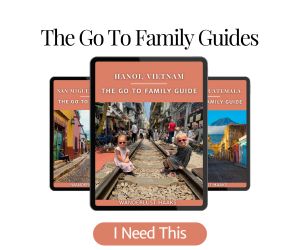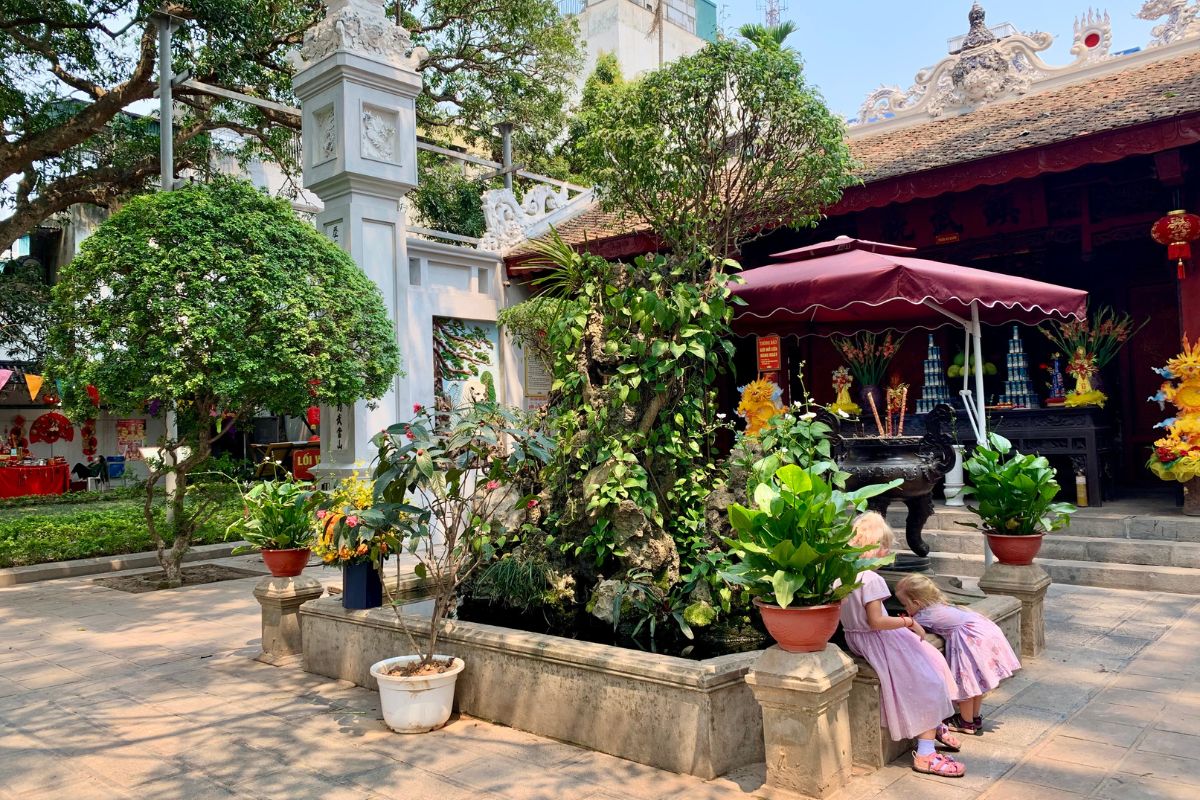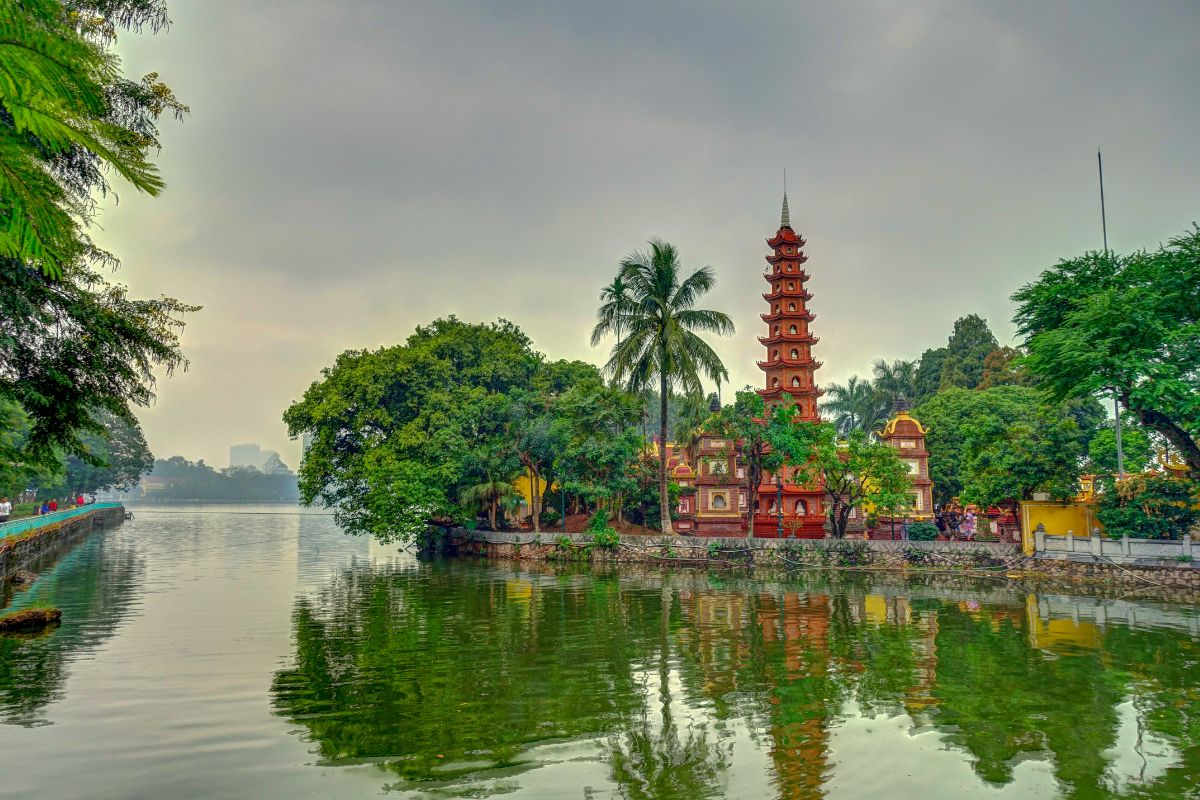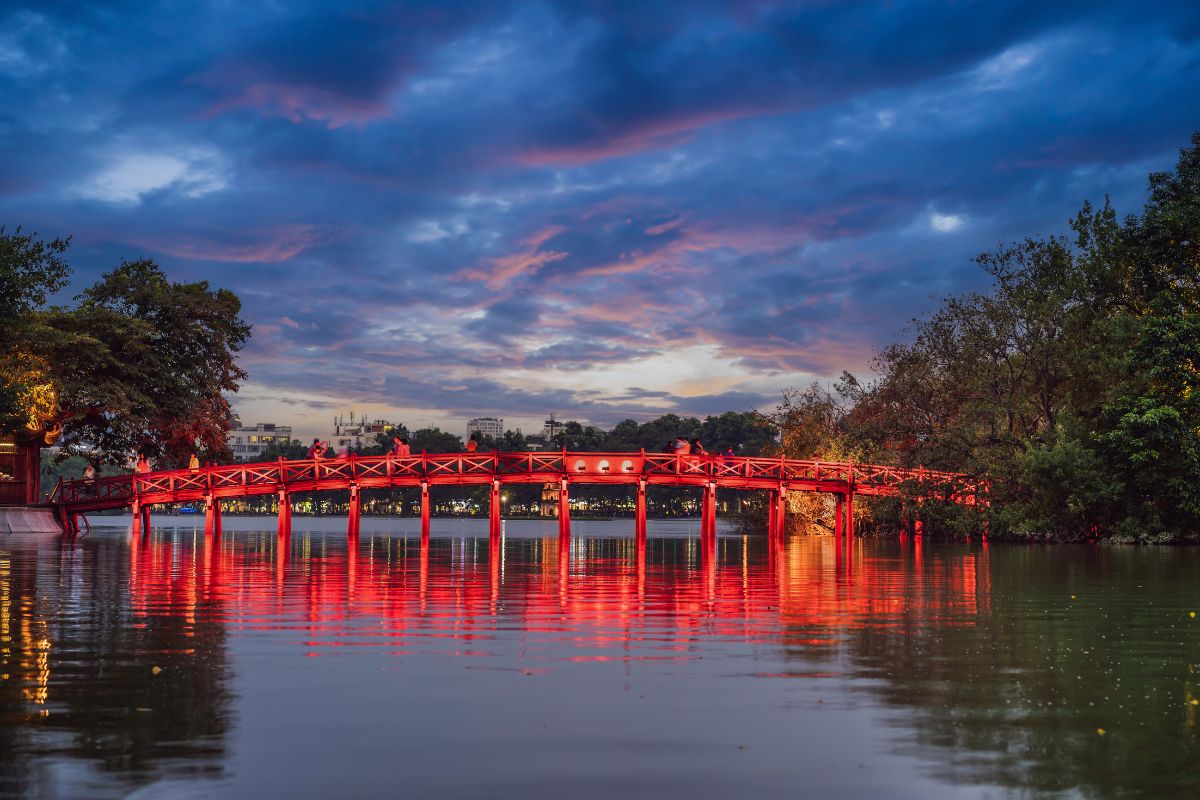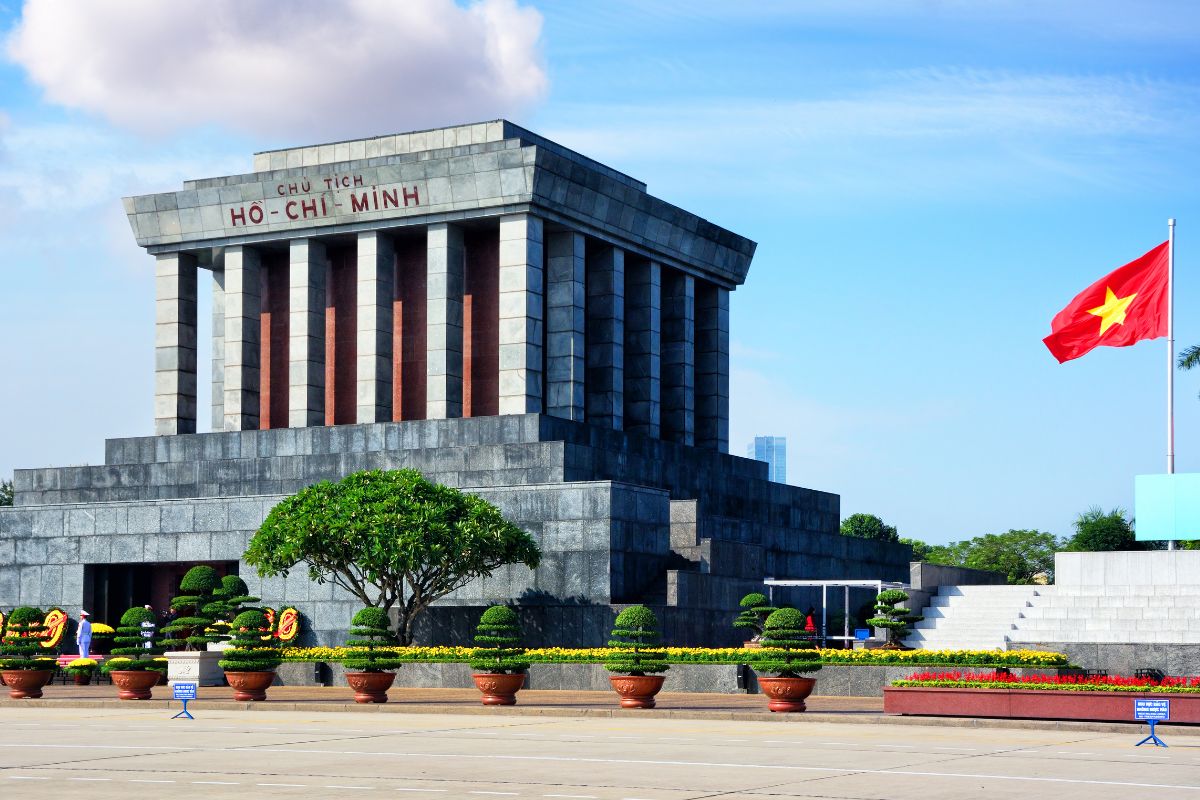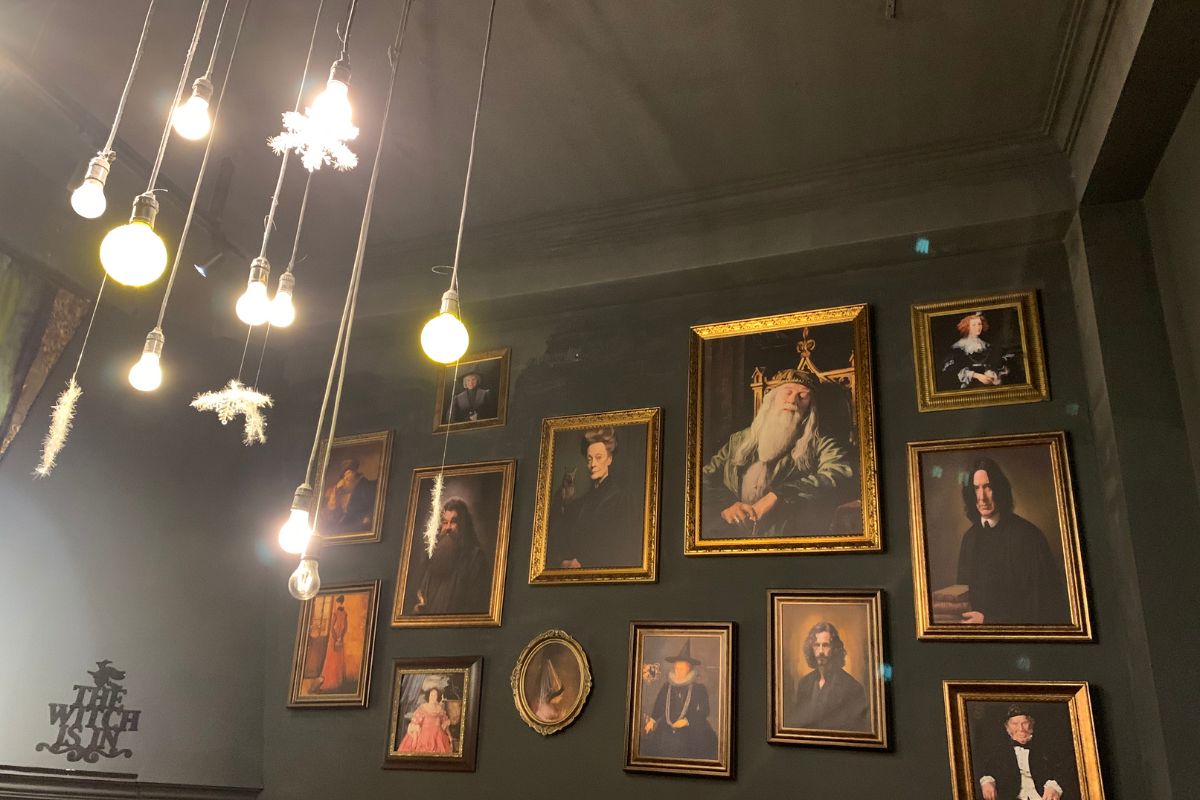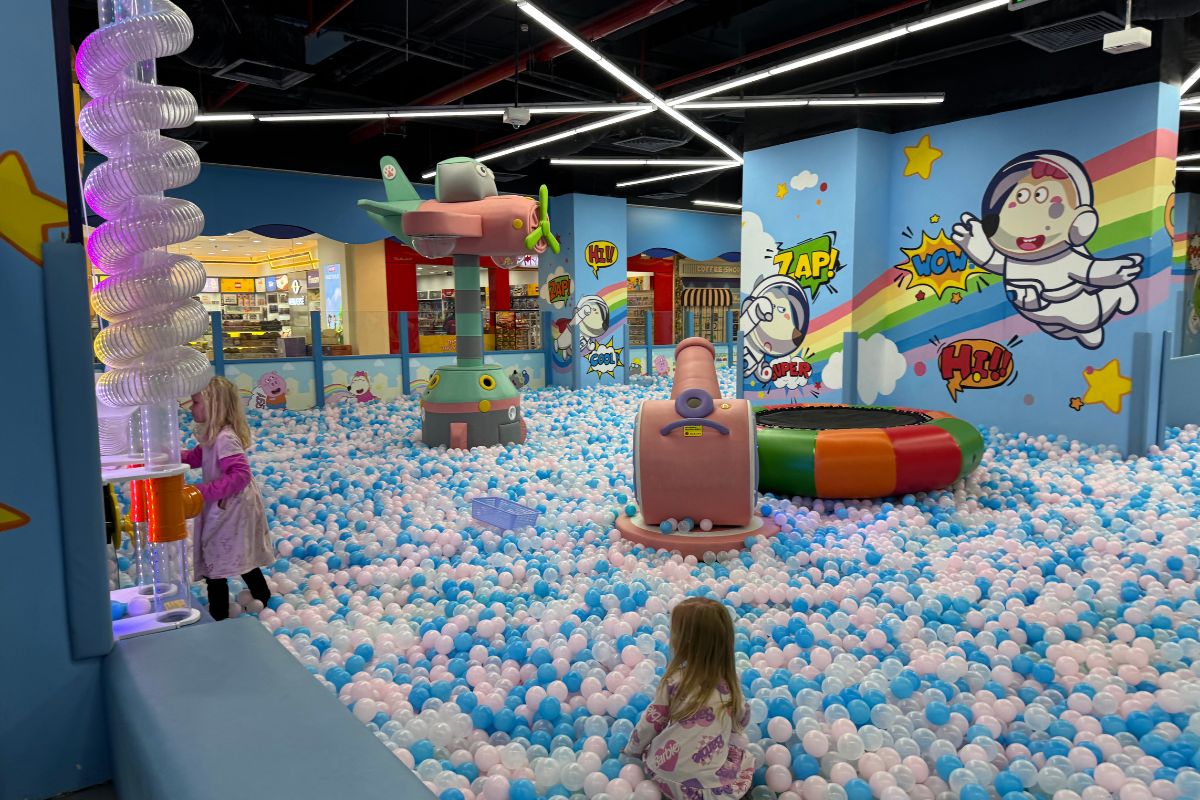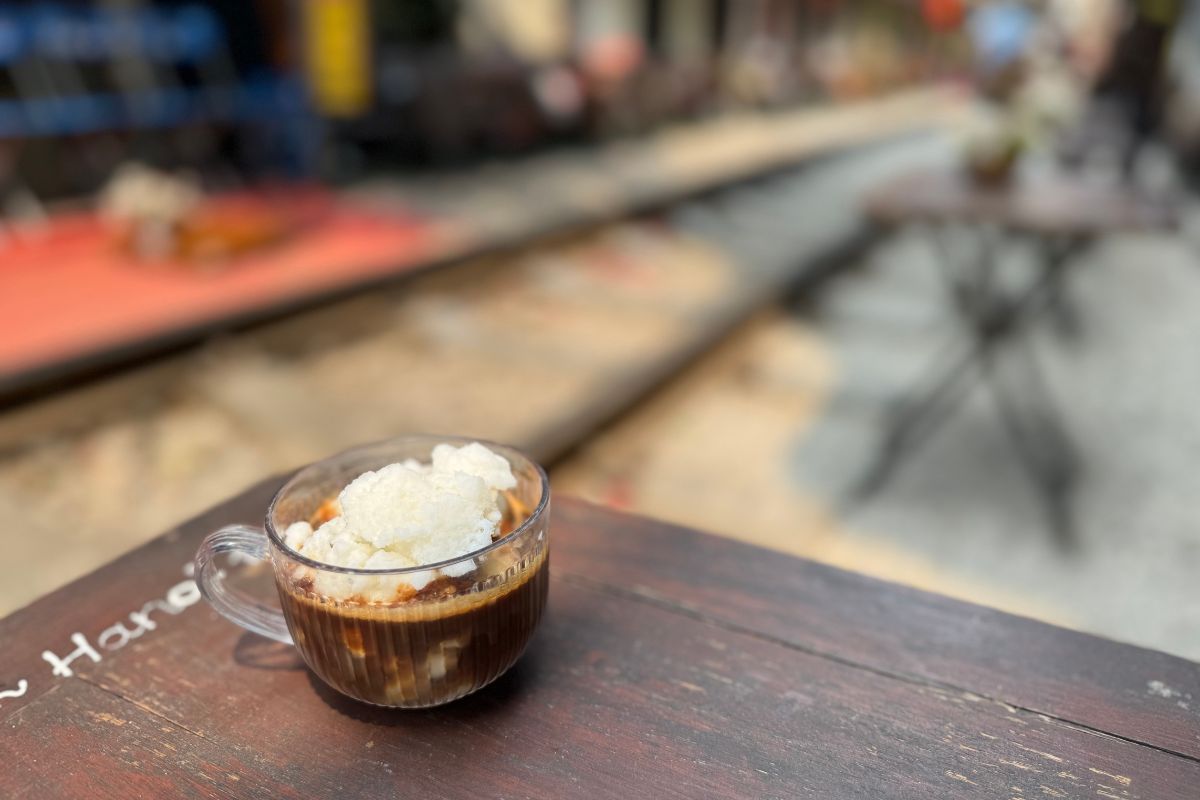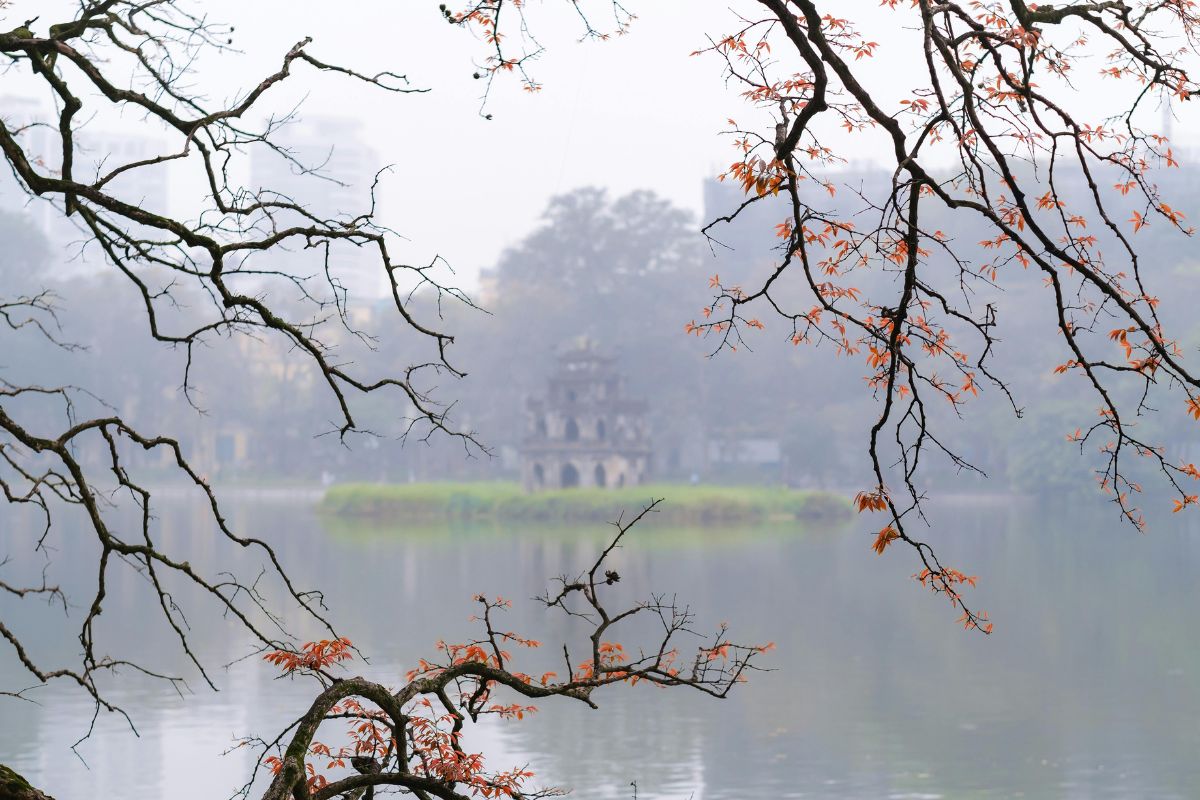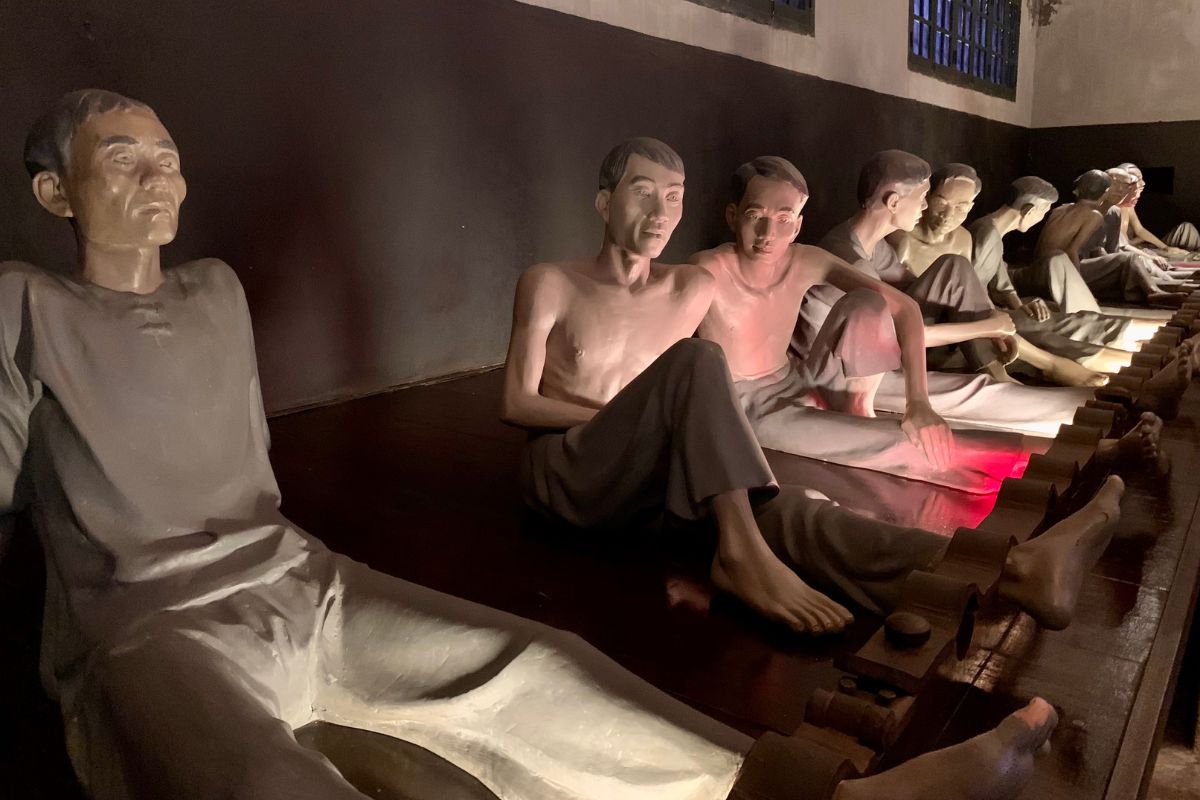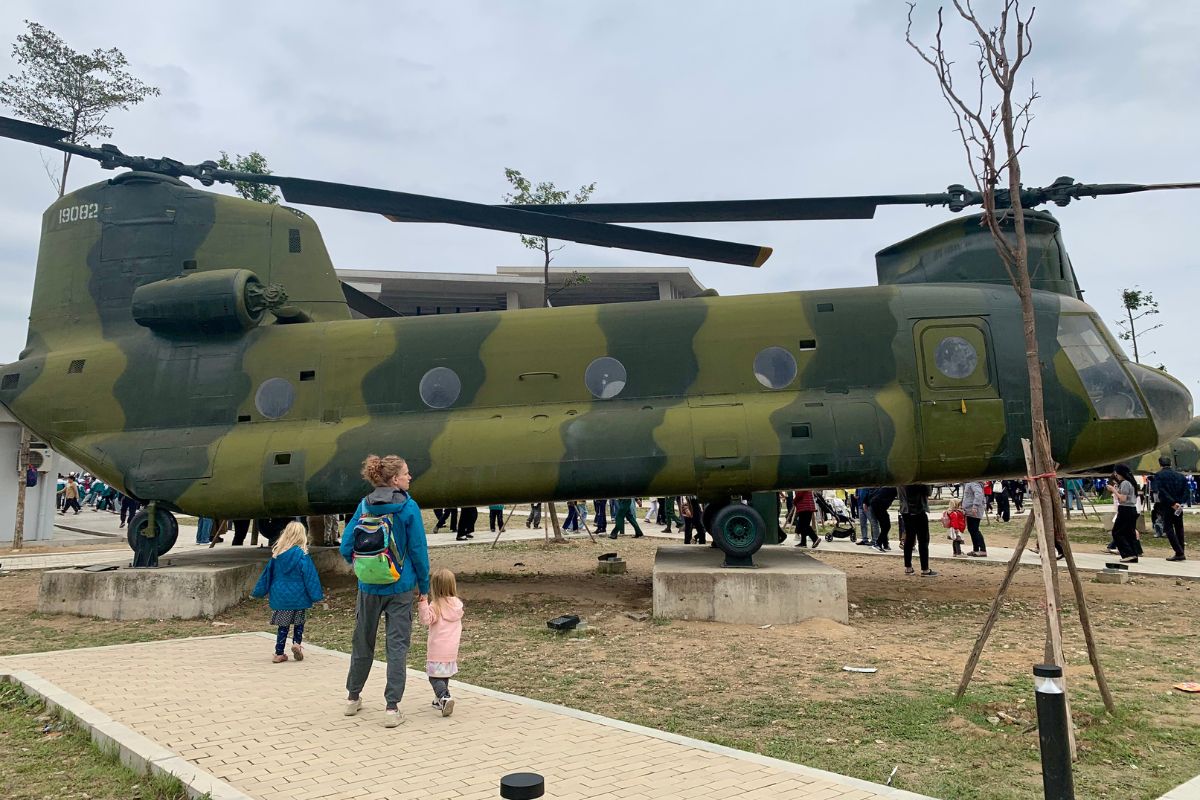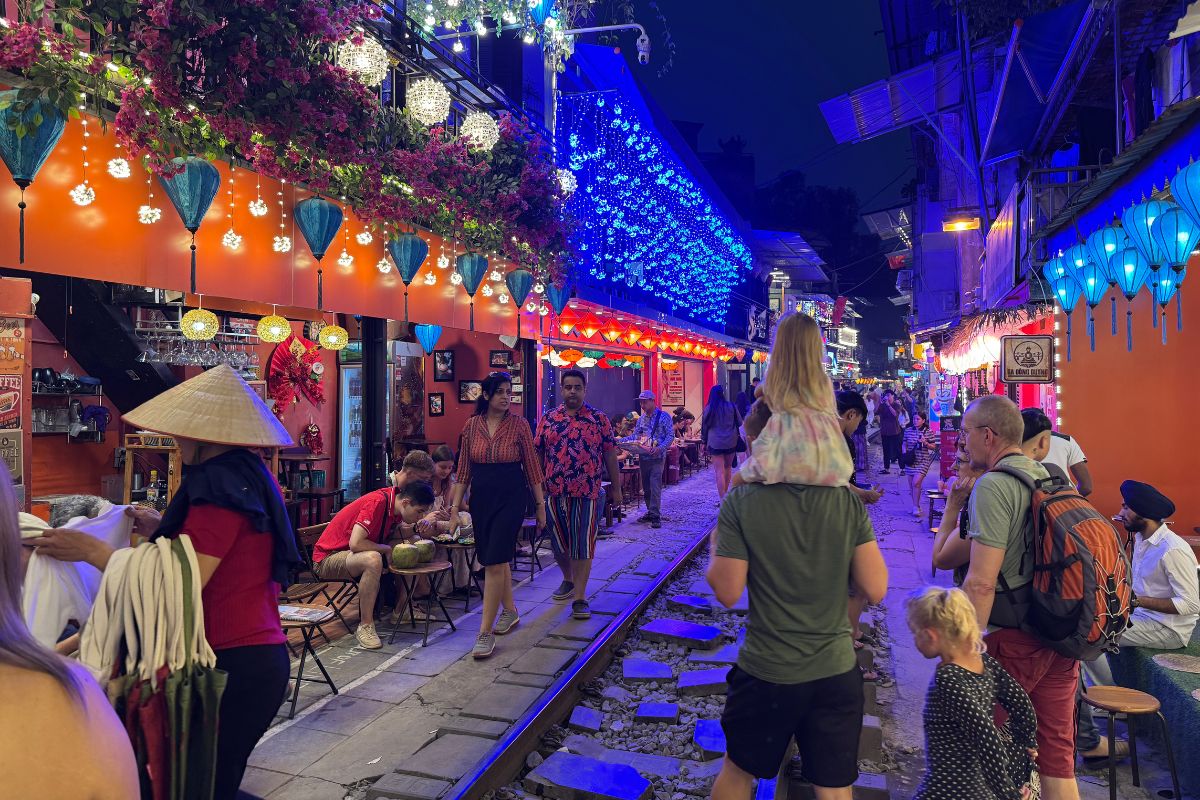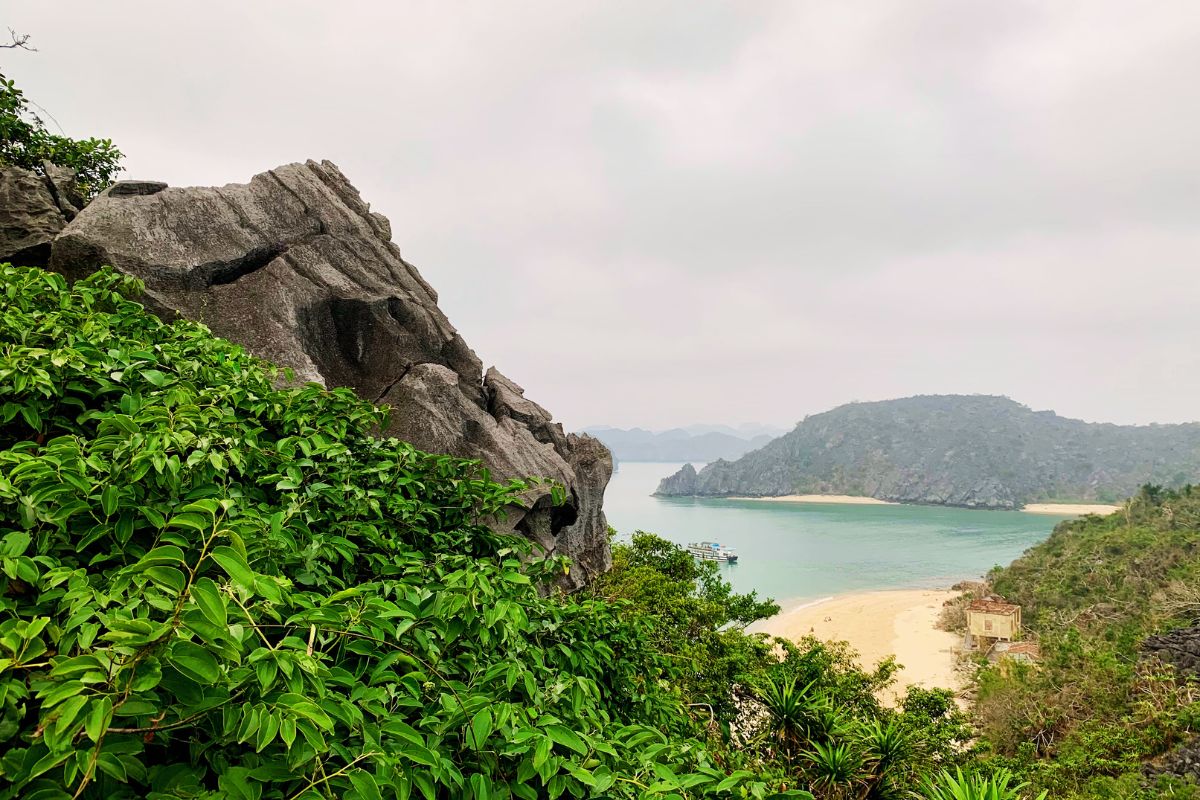If you’re a parent wondering whether Hanoi is worth visiting with little kids, let me be the first to tell you: Yes. But also—be ready. Hanoi is loud, unpredictable, full of charm, and surprisingly doable with young kids if you know what you’re walking into.
We spent just a month in Hanoi with our 2- and 5-year-old and, while it wasn’t always smooth sailing (what family travel is?), we found a rhythm. What made it worth it wasn’t a checklist of “top 10 things,” but rather how Hanoi fit into our family’s pace, preferences, and goals while traveling long-term.
Here’s what we loved, what worked with kids, and what’s honestly not worth your time unless you’re ready for some chaos.
Why We Chose Hanoi (and Why You Might, Too)
We didn’t choose Hanoi because it’s Vietnam’s most famous city—it just made logistical sense for our family at that moment. We needed a major international airport to fly out of for our next country, we were craving milder weather after 2.5 intense months in India, and my husband really wanted to visit Ha Long Bay, which is most easily accessed from Hanoi. All roads led north.
That’s something I always tell other families considering long-term travel: sometimes it’s less about “what’s best on paper” and more about what fits your route, your goals, and your current bandwidth. Hanoi wasn’t our bucket-list city, but it turned out to be exactly what we needed.
Why Hanoi Worked for Our Family:
- Major international hub: Nội Bài International Airport (HAN) is well-connected and has direct flights to cities across Asia and beyond. It’s about 45 minutes from the city center and is clean, efficient, and relatively easy to navigate—even with kids and luggage in tow.
- Spring weather: From March to mid-April, Hanoi averages 18–26°C (64–79°F). Mornings and evenings can feel crisp (especially after hot, muggy weather elsewhere in Southeast Asia), but the afternoons tend to be warm and occasionally humid. We experienced some light rain, mostly in short bursts.
- Shoulder season perks: Fewer tourists compared to peak winter months (Dec–Feb) or summer (May–August), which made attractions less crowded and accommodation slightly more affordable.
- Access to day trips: Hanoi is a great base for family-friendly excursions to Ninh Binh, Trang An, or even an overnight trip to Ha Long Bay or Cat Ba Island.
How the Kids Handled It
By the time we got to Hanoi, our 2- and 5-year-old were seasoned travelers. After navigating India’s extreme crowds, pollution, and sensory overload, Hanoi felt calmer—even with the scooter madness. The traffic is still intense (we’re talking motorbike mayhem), but not chaotic in the same way.
That said, Hanoi is not stroller-friendly. Let me save you the trouble now: the sidewalks are basically a non-option. They’re either covered in parked scooters, makeshift street stalls, or used as actual traffic lanes. You’ll end up pushing your stroller in the street or carrying it over obstacles. Unless you’re using an ultra-light travel stroller and you really don’t want to use a carrier, I recommend skipping it.
We used a hard-structured carrier every single day—and we were so glad we had it.
Traditional PhoMust-Try Foods in Hanoi (That Even Picky Kids Will Eat)
Let’s be real: feeding kids abroad can be a battle. But Hanoi? Surprisingly easy.
Ours devoured phở, fried spring rolls, and anything with rice and grilled meat. We found some gems at the night markets, where we could graze at our own pace. Just know that most stalls only take cash, so come prepared.
Pro tip? Check out my other blog post on where to get coffee in Hanoi—because yes, you’ll need it, and yes, it’s incredible.
Cultural Sites That Kids Actually Liked
I wasn’t sure how temples and museums would go with a toddler and a preschooler, but honestly, they surprised me. We didn’t do any bribes or games—just let the kids take the lead and asked questions along the way. They ended up being fascinated by the incense, Buddha statues, and especially the food offerings—everything from soda and beer to full roast ducks. It made for some great conversations.
Here’s what we visited and what you should know before you go:
Kids Exploring The TempleQuan Thanh Temple
This temple is located near West Lake and is dedicated to the God of the North, Trấn Vũ. It’s quiet, shaded, and has an old banyan tree and a huge bronze statue that weighs over 3,600 kilograms. There are dragons carved into the walls and altars, which caught our kids’ attention right away.
Entry cost was 10,000 VND per adult. The space is small enough to explore in 30–45 minutes, and we appreciated the calm atmosphere after being in the busier parts of the city. You’ll need to dress modestly—shoulders and knees should be covered to enter.
Oldest Pagoda In HanoiTrấn Quốc Pagoda
This is the oldest pagoda in Hanoi, dating back to the 6th century, and it sits right on a little island in West Lake. It’s a scenic spot with a tall red stupa and smaller shrines surrounding it. There’s also a sacred Bodhi tree that was gifted from India. Our kids liked walking around and spotting the golden Buddha statues placed all around the courtyard.
There’s no entrance fee, but modest dress is required here as well. This is an active place of worship, so be respectful if a sermon is happening during your visit. It’s easy to pair this stop with Quan Thanh Temple since they’re both in the same area.
Exploring the MuseumVietnam Museum of Ethnology
This museum ended up being a kid favorite. The outdoor area has full-size houses from different ethnic groups across Vietnam, and you’re allowed to go inside, climb the ladders, and walk through the spaces. Our kids treated it like a mini obstacle course—and they were learning the whole time.
We walked by most of the indoor exhibits because of attention spans, but they focus on cultural clothing, tools, instruments, and traditions. Entry was 40,000 VND per adult. You’ll need to remove your shoes before entering some of the structures, so keep that in mind.
Bridge to the TempleNgọc Sơn Temple
We didn’t go inside this one, but we walked past it many times. It sits on a small island in Hoàn Kiếm Lake and is connected by a red wooden bridge you’ve probably seen in photos. It’s a popular spot, and there’s a preserved giant turtle inside the temple that draws a lot of attention.
Entry is 30,000 VND for adults and 15,000 VND for children. The bridge and the view alone are worth the stop, especially if you’re already walking around the lake.
Ho Chi Minh MausoleumHo Chi Minh Mausoleum
This is a major landmark in Hanoi where Ho Chi Minh’s embalmed body is kept and open for public viewing. We didn’t go inside as it wasn’t open anyways for visiting. Still, it’s worth noting for families with older kids or anyone interested in Vietnam’s political history.
There’s no entrance fee, but it’s only open in the mornings and closed on Mondays and Fridays. Dress modestly here—this is one place where they’re strict. You’ll also find Ho Chi Minh’s stilt house and the Presidential Palace nearby, which require a small fee if you want to go in.
Walking in Old QuartersWalking the Old Quarter with Kids: Tips for Surviving the Chaos
The Old Quarter is one of the most intense and fascinating parts of Hanoi. It’s chaotic, colorful, and alive with energy—basically, a sensory playground for adults and kids alike. But with that comes the reality: it’s loud, the sidewalks are mostly unusable, and there’s no such thing as a peaceful walk.
It’s also where you’ll find some of the best local food, cafes, street vendors, and shops. The streets are narrow and often filled with parked motorbikes, food stalls, and people just going about their day. Sidewalks are treated like extra parking, which means most of the time, you’ll be walking directly in the road with scooters weaving around you.
And no, traffic rules don’t really apply here in the way many travelers are used to. Crossing the street in Hanoi is more of an art than a rule. Our Airbnb host gave us the golden rule: walk slowly and confidently across the street. Don’t run, don’t stop suddenly—just keep a steady pace so motorbikes can adjust and go around you. It feels wrong at first, but it actually works.
Would I walk the Old Quarter with kids again? 100%.
But I’d do it the same way we did the first time, with a few lessons learned along the way:
- Use a carrier. The sidewalks are so blocked, pushing a stroller looks like a full-body workout, and you’ll constantly be lifting it over curbs, weaving through scooters, or giving up and walking in traffic. We brought our hard-structured carrier and used it every single day.
- Avoid wide strollers at all costs. If you really need one, make sure it’s super compact and lightweight—something you can easily pick up and maneuver.
- Plan breaks. We found a public workout area near the north end of the Old Quarter—basically a big concrete plaza where locals do tai chi and kids can safely run around. This was our go-to spot when the kids needed space or when we just wanted a break from navigating traffic.
Best Places to Chill (a.k.a. Recharge with Coffee and Calm)
Sometimes, you just need a place where the kids can play and you can breathe.
We loved:
- Always Café – a Harry Potter-themed café that’s fun for kids and magical for adults.
- Indoor playgrounds – like Wolfoo World or Babiland Kids Café, where the entry fee covers unlimited play in a clean, shoe-free, supervised space.
- Hoàn Kiếm Lake – especially at night when locals bring out mini scooters for rent and the whole city seems to gather.
And for me? A cold canned Vietnamese coffee from Winmart was life. Inexpensive, tasty, and always accessible.
Trang AnDay Trip to Ninh Binh: Totally Worth It
We did a DIY day trip to Ninh Binh, and it was one of our favorite days.
We bought train tickets directly at the Hanoi station (much easier than in India, where we relied on 12Go.asia), took a two-hour ride, and then Grab’d our way to Tràng An for a boat ride through caves and limestone cliffs.
We also climbed the steps to Mua Cave, which had epic views and space to roam.
It’s all manageable with kids—and no, you don’t need a tour guide. Check our my entire blog post about Ninh Bing here.
Hidden Gems Worth Checking Out
Not everything worth seeing in Hanoi shows up on the top 10 lists—and honestly, those quieter, less-hyped spots often end up being the most memorable. Here are a few off-the-beaten-path places we loved that are especially good for families.
In Wonder At HLC Starry Sky Art MuseumHLC Starry Sky Art Museum
This one took some hunting to find, but it was 100% worth it. It’s an immersive art experience located deep inside the Vincom Mega Mall Royal City. Think light tunnels, mirror rooms, and interactive exhibits that feel like you’re walking through a giant Instagram filter. The kids loved it because they could move around freely, and we liked it because it wasn’t crowded and gave us a solid break from the chaos outside.
If you’re looking for it, don’t rely on Google Maps alone—it’s easiest to enter the mall at the southernmost entrance, take the escalator down two levels, and walk toward the roller skating rink. The art museum is tucked right next to it. Tickets were around 150,000 VND per person when we went.
Coffee with Train ViewsHanoi 1990s Café on Train Street
We’ve all seen the iconic shots of Hanoi’s Train Street—narrow tracks running right through a neighborhood, with trains flying past cafés just inches away. What a lot of people don’t realize is that the main stretch of Train Street is often closed off now due to safety rules. But we found Hanoi 1990s, a tucked-away café on the south side that still gives you a front-row view of the train. I initially found them on Instagram and contacted them directly for a reservation, which allowed us to also show up at the right time.
This is so intense and likely just because I have kids and just felt like you could reach out and touch the train so easily, but still a fun experience nonetheless.
Kids Loved the Water Puppet ShowThe Water Puppet Show
Our Airbnb host told us we had to check out the traditional water puppet show, and I’m glad we listened. It’s about an hour long, held near Hoàn Kiếm Lake, and features wooden puppets performing in waist-deep water with live traditional music and narration.
Even though most of the narration is in Vietnamese, our kids were totally into it. The puppets are colorful, the stories are short, and it’s just really entertaining. If you’re traveling with little ones, it’s a fun cultural experience that won’t lose their attention. We bought our tickets at the theater a couple hours before because they tend to sell out, especially on weekends. Also, difference sections cost different amounts whether you want the front, middle or back of the theater, but the front is totally worth it at 200K VND per adult.
What to Pack (Based on What We Didn’t)
We traveled to Hanoi in March through mid-April, which meant the weather could not make up its mind. One minute it was warm and sunny, the next it was damp, breezy, or raining—and then came the sticky humidity. If you’re packing for Hanoi with kids, especially during the spring shoulder season, you’ll want to be prepared for everything from misty mornings to sweaty afternoons. Click here to see our packing list!
Here’s what we learned—some from experience, some the hard way.
What We Were Glad We Had:
Quick-dry clothing
Humidity is no joke in Hanoi, and it makes drying laundry (even indoors) take way longer than expected. Lightweight fabrics that dry quickly were a lifesaver for both adults and kids. We packed shirts and pants made from moisture-wicking material and avoided heavy cotton. When clothes stayed damp too long, they started to smell—so this one’s non-negotiable.
Layerable outfits
The temperatures ranged from low 60s to high 70s (°F), so we dressed the kids in layers they could peel off as the day warmed up. Long-sleeved shirts over tank tops, leggings under dresses—simple swaps like that made it easy to adjust without overpacking.
Light jackets or fleece pullovers
We didn’t expect to need these, but on cloudier days or early mornings, they really came in handy. Even though Hanoi isn’t cold, the breeze off the lake and the lack of strong sun made it feel cooler than the temperature showed.
A lightweight carrier
Not technically clothing—but close. Since sidewalks in the Old Quarter are practically unusable, a structured carrier made getting around with our toddler so much easier. We wore it daily, especially in crowded markets and on public transport.
Waterproof jackets or packable ponchos
It didn’t rain constantly, but when it did, it came out of nowhere. We kept compact rain jackets in our day bag just in case, and they definitely got used. If you’re debating between umbrellas and jackets—less to juggle when you’ve got kids with you.
What We Wished We Had:
A travel drying line
Laundry took forever to dry inside our Airbnb, and there wasn’t always space to hang things. A simple elastic drying line would’ve saved us from draping damp clothes over every available chair.
More long-sleeved tops and pants
We didn’t expect Hanoi to feel as cool as it did some days. We ended up re-wearing the same couple of long-sleeved items on repeat. I’d recommend packing at least two long-sleeved shirts and a couple pairs of lightweight pants or leggings per person—even if you’re coming from somewhere warm.
Dehumidifier packs
This is more of a niche tip, but if you’re staying somewhere with limited ventilation, little packets of silica or charcoal dehumidifier bags can help keep your closet or laundry area from feeling musty. We didn’t have any, but definitely wished we had something to help dry things out faster.
Getting Around: Our Favorite Hacks
Transportation in Hanoi was honestly easier than I expected—with a few things that really helped us stay sane while navigating the city with kids in tow.
Grab is your best friend
We used Grab almost daily. It works just like Uber—you download the app, type in your pickup and drop-off locations, and the driver comes to you. Payment is handled through the app, so there’s no need to negotiate or fumble with cash. It gave us the flexibility to head home when the kids melted down, and it made longer distances—especially in unpredictable weather—a non-issue.
We found drivers to be polite and on time, and the app even shows you the license plate and driver photo for safety. Some drivers text via the app to confirm the pickup location, so having Google Translate ready was helpful for quick communication.
Tip: Double check that the pin drop matches your actual location before confirming—sometimes the GPS isn’t perfect, especially in crowded areas.
What we skipped
We chose not to bring or use car seats, which I know is a personal decision. Most Grab cars didn’t have them, and carrying one around didn’t make sense for the kind of travel we were doing. If you’re traveling with babies or toddlers and car seat safety is non-negotiable for your family, you’ll want to either:
- Bring a compact travel car seat or a harness-style system (like RideSafer)
- Stick to walking and trains where you don’t need one
Bonus Stops That Deserve a Mention
There are a few more places we either visited or had planned to visit that I think are worth adding to your itinerary if you’re in Hanoi with kids. These didn’t all fit neatly into a category, but they’re important to mention because they offer a fuller picture of what the city has to offer—beyond just the major temples and puppet shows.
Hoan Kiem LakeHoàn Kiếm Lake
This is the lake at the center of the Old Quarter and one of the easiest landmarks to access no matter where you’re staying. No, it’s not a swimming lake, but it’s a central part of life in Hanoi. Locals gather here to walk, meet friends, or just hang out with their families. At night, the area comes alive—vendors set up little scooters for rent, people dance or exercise in the square, and the streets close off to cars, making it easier for kids to roam around.
Even if you don’t spend hours here, you’ll likely end up circling the lake on your way to or from somewhere else. It’s surrounded by cafes and street vendors and is home to Ngọc Sơn Temple, which sits on a small island in the middle.
Hoa Lo PrisonHỏa Lò Prison (The Hanoi Hilton)
This one isn’t for everyone, but it’s historically significant. Originally built by the French to imprison Vietnamese revolutionaries, it later held American POWs during the Vietnam War. It’s an intense visit—some parts are emotional, some are hard to explain to kids, and some are clearly told from the Vietnamese government’s perspective, especially when it comes to the treatment of American soldiers.
There are original cells, personal stories, and wartime propaganda displays. Entry is 50,000 VND per adult. The dress code wasn’t strictly enforced when we went, but it’s a respectful space, so I’d still recommend covering up.
Vietnamese Women’s Museum
We didn’t make it to this one, but I’ve heard great things. It’s a museum entirely dedicated to the role of women in Vietnam’s culture and history—covering everything from wartime service to motherhood to traditional fashion. If your kids are interested in stories and visuals, this might be a good indoor option for a slower-paced day.
Temple of Literature
This was high on our list, but unfortunately we didn’t make it because our bank card stopped working near the end of our trip. Still, it’s Vietnam’s first national university, dating all the way back to 1070. It’s known for its peaceful courtyards, stone stelae, and traditional pavilions. The entry fee is 70,000 VND per adult, and I’ve heard it’s a great photo spot. Definitely worth visiting if you’re interested in Vietnamese education, Confucian history, or just want to explore something quieter and beautiful.
US Huey HelicopterVietnam Military History Museum
This one’s a toss-up depending on your interests, but we wanted to experience it. The museum covers Vietnamese military efforts from ancient times through modern conflicts. There are indoor galleries with uniforms, maps, and propaganda posters, but the real draw is the outdoor area, where you can walk around massive military aircraft and tanks—including a downed B-52 and a MIG-21 fighter jet.
We ended up going on what must have been a veteran event day, because the place was packed with older Vietnamese men in military uniforms. Entry is 30,000 VND per adult on regular days. If you’re interested in war history and your kids are into big machines, this is worth a visit.
Final Thoughts: Is Hanoi Worth It for Families?
Yes—without a doubt. Hanoi has this energy that’s hard to explain until you’ve been there. There’s history everywhere you look, the food is incredible (and surprisingly kid-friendly), and there’s just enough room to slow down and enjoy it all—even with little kids in tow.
Was it perfect? No. It was chaotic, loud, and at times overwhelming—but it was also colorful, full of character, and completely different from anywhere else we’ve traveled. Our kids adjusted better than we expected, especially after coming from India. They got used to crossing busy streets, eating new foods, and learning to explore at their own pace.
We didn’t check off every tourist attraction—and that was intentional. Instead of rushing through a list, we focused on what worked for our family: exploring the Old Quarter, trying local food, visiting temples they actually enjoyed, and finding indoor play areas when we all needed a break.
There are plenty of cities in Vietnam that are great for families, but Hanoi is especially worth considering if:
- You want to base yourself somewhere with easy access to day trips like Ninh Binh or Ha Long Bay
- You like staying in places with deep history and culture
- You’re okay with some chaos and are flexible with your daily plans
Would we go back? Definitely. We didn’t see it all, but we experienced enough to fall in love with it. And if we ever return to Vietnam, Hanoi will still be high on our list—this time with an even better understanding of how to do it right with kids.
More on the Blog:
Did you know Hanoi was a foodie paradise? Check out our favorite places to eat.

